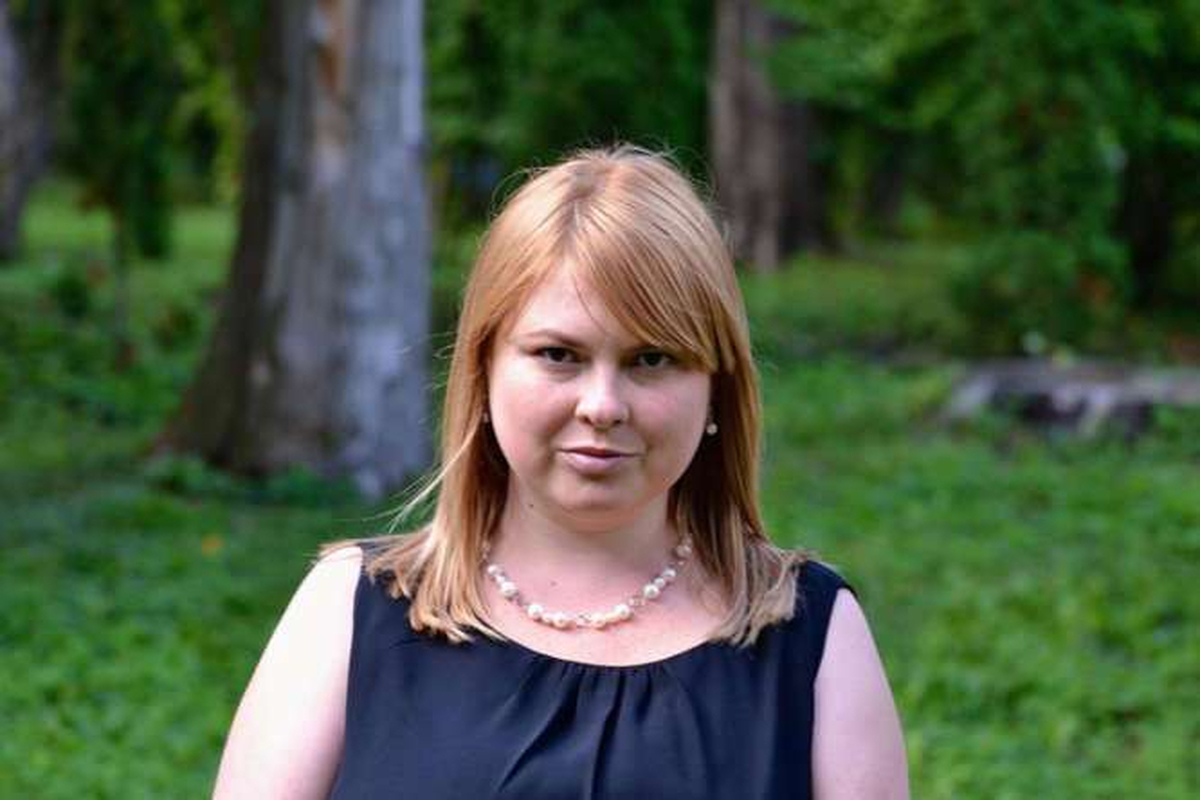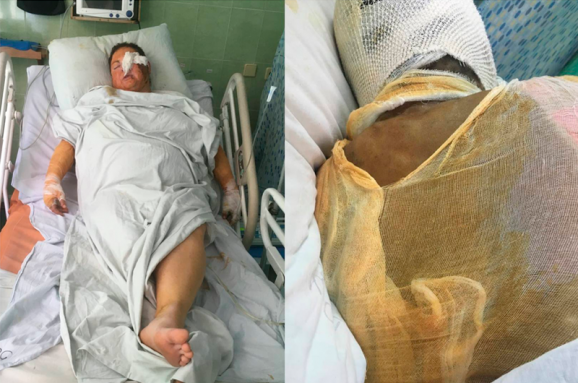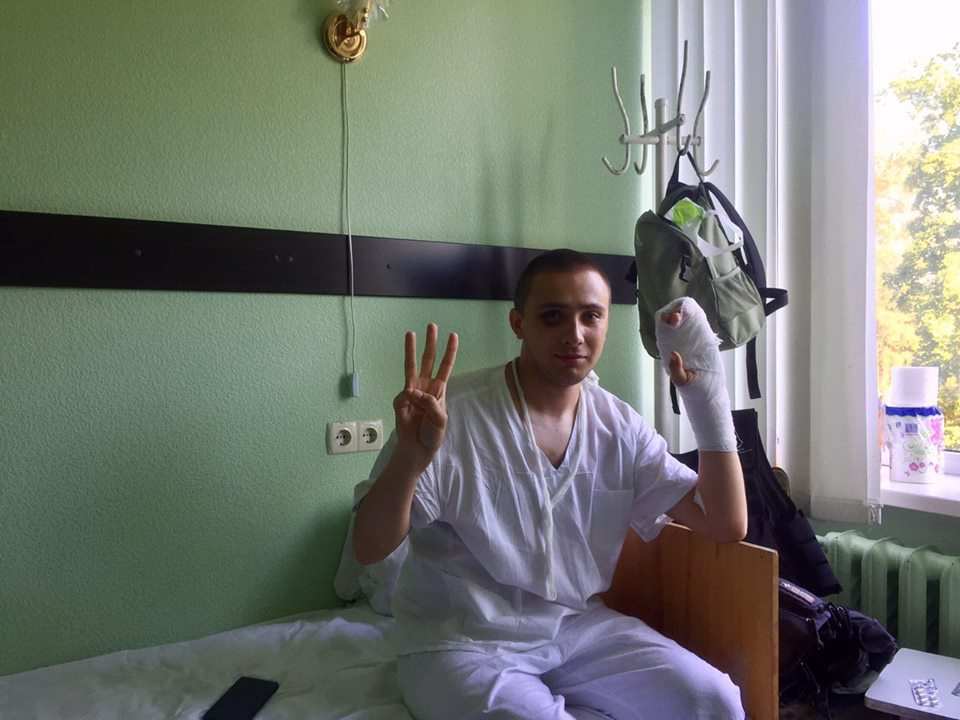In one and a half year 55 activists in Ukraine were attacked by unknown assailants for their fight against corruption. Arrests were made but there is a clear reluctance of the authorities to act or even to speak out against these horrific attacks. According to slavicist Tobias Wals it is a clear sign that Euromaidan has failed to defeat the corrupt structures in Ukraine. And the West is reluctant to act.
 Activist Kateryna Handziuk from Kherson in July was heavily mutilated after an attack with sulphuric acid
Activist Kateryna Handziuk from Kherson in July was heavily mutilated after an attack with sulphuric acid
by Tobias Wals
On the evening of September 27, around 500 Ukrainian activists gathered for a protest rally in the centre of Kyiv’s government district. The Night on Bankova Street, as the demonstration was called, aimed to sound the alarm after a recent number of violent attacks on Ukraine’s civil society, the most notable of which was the case of Kateryna Handziuk — a corruption fighter from Kherson who suffered severe injuries from an assault with sulphuric acid last July. Five suspects have been taken into custody on charges of attempted murder, but the larger question of who ‘ordered’ the crime remains unanswered.
Earlier in September the so-called Handziuk List was published: an overview of no less than 55 assaults on activists from all over Ukraine, committed over the last one and a half year, that have remained unresolved. A worrying trend is to be seen in Ukraine, as its highly vocal civil society — one of the main achievements of Euromaidan — is increasingly facing violence.
But what’s even more worrisome is the apparent reluctance of the authorities to take action or even condemn the attacks. Hence the slogan of the Night on Bankova St. rally: silence kills.
Euromaidan failed
Almost five years after the Euromaidan protests started, it is more evident than ever that the Revolution of Dignity — as it is usually called in Ukraine — failed to radically transform Ukrainian politics. The end of Viktor Yanukovych’s authoritarian regime did not, as many hoped, usher in an era of free democratic competition. Of the dozens of new parties that were founded after Euromaidan, most got stuck in the embryonic stage. None came close to jeopardizing the oligarchic establishment.
Instead, Yanukovych’ rivals — Petro Poroshenko above all — conveniently reinvented themselves as pro-Western reformists and thus were able to win new support for their façade parties.
The artificiality of this move was (once again) showcased by the recent struggle over the Supreme Anti-Corruption Court. The creation of such an organ was one of the conditions imposed by the IMF as part of Ukraine’s 17.5 billion dollar bail-out deal. But president Poroshenko was so reluctant to set up an independent court — which has the potential to compromise his administration — that he almost let the national currency collapse, before finally coming through last June.
The fact that Poroshenko’s biggest contester in the polls for the 2019 election is Yulia Tymoshenko, oligarch par excellence, just goes to show how little Euromaidan has changed Ukrainian politics.
Civil society boom
There was, however, one ray of light that Euromaidan cast upon the Ukrainian political landscape: something one might call the civil society boom. Inspired by the mass protests on Kyiv’s Independence Square, a broad stratum of society — very often women — became politically aware and claimed their say in the country’s running.
Euromaidan was the cradle of critical, non-oligarchic media such as Hromadske and Euromaidan Press, as well as a host of ngo's involved in reform monitoring and corruption fighting, with names like the Anti Corruption Action Centre and Reanimation Package of Reforms.
Sometimes jokingly called грантоїди, or ‘grant eaters’, because of their reliance on Western subsidies, the activists working in these organisations occasionally exert critical leverage over the Poroshenko administration. They played a key role in the creation of the Supreme Anti-Corruption Court, by torpedoing two earlier drafts and proposing amendments to the final design. Together with the IMF and the EU, the ngo's have been keeping the pressure on the government and forcing it to push through reforms it is not eager to carry out.
But Euromaidan’s greatest feat, that which sets it apart from the 2004 Orange Revolution, is that it wasn’t an exclusive ‘Kyivan’ affair—it also provided an impulse for civil society on a local level, where corruption and mismanagement are often even more blatant than in the capital.
It is no exaggeration to state that the revolt spirit of Euromaidan gave many Ukrainian citizens the courage to go after their local kleptocrats and cronies, as well as the momentum to actually get some of them ousted from office.
The attack on Handziuk
Kateryna Handziuk, for instance, was partly responsible for the demotion and replacement, earlier this year, of Artem Antoshchuk, a high police officer from Kherson, whom she accused of corruption. Handziuk (1985) began her career as an activist in the mid-2000s. Both critical and pragmatic, she got herself elected into the Kherson city council for Tymoshenko’s Motherland party after Euromaidan, but was soon kicked out of the party. Even as a member of the city council and confidant of the (non-aligned) mayor of Kherson, she retained her ‘active civil position’ — as it is called in Ukraine.
 Handziuk in hospital, more then 30% of her body burned by acid. Arrests were made but no progress in the case (picture Euromaidan Press)
Handziuk in hospital, more then 30% of her body burned by acid. Arrests were made but no progress in the case (picture Euromaidan Press)
She is known for her ardent patriotism and inclination towards confrontation. Apart from the local police corps, she recently went after politicians of the Socialist Party, whom she accused of promoting Russian interests in Kherson, and many, many others.
Handziuk was attacked in the morning of July 31, as she was leaving her house. A young man approached her from behind and poured a litre of sulphuric acid over her head. She was immediately hospitalized and later transported to the national Burn Centre in Kyiv, where she is still recovering from her injuries. Over thirty percent of her body has been affected.
Few people doubt that the assault was meant as a warning, either to Handziuk herself or to other activists in the region. In her first interview after the attack, with Hromadske, Handziuk stated that she has ‘had too many conflicts to determine which one of them could have been the reason.’
Handziuk refused to cooperate with the local police forces, but changed her mind when her case was handed over to the Department of Strategic Investigations, a recently created elite force within the national police. However, three months after the investigation started, the question of who ordered the attack remains unresolved and the investigation seems to have stranded, leaving Ukrainians to wonder whether the authors of the crime are being protected by a cover-up.
Kateryna Handziuk’s case caused quite a stir in Ukraine, because of her well-know persona and the cruelty of the attack. But as the Handziuk List reveals, her case is far from unique. Similar attacks take place on a weekly basis, all over the country. And the frequency shows a clear upward trend. These are just some random picks from the 55 entries on the list, which was published by friends and colleagues of Handziuk:
Legal activist Iryna Nozdrovska was found dead in the forests north of Kyiv on January 1, 2018, after a two-day search. She had, among other things, been working on the case of her sister, who was beaten to death by the nephew of a local judge in March 2015. The nephew escaped conviction; the murderers of Nozdrovska have not been identified.
Eco-activist Vasyl Dmytryshyn was beaten up by a group of men on March 2, 2018. The assault has been linked to his struggle against the local ‘lumber mafia’ in the foothills of the Carpathian mountains, south of Lviv. His attackers, one of whom Dmytryshyn managed to injure with a gun, are being charged with ‘disorderly conduct’ (хуліганство).
Borys Zolotchenko of the ngo Gay Alliance Ukraine was attacked by five masked men as he was leaving an LGBT community centre in the city of Kryvy Rih, on January 21, 2018. The men used tear gas and physical violence. On June 30, Zolotchenko was attacked again after a meeting of the local gay pride committee. In neither case the attackers were convicted.
As the Revolution of Dignity is approaching its fifth anniversary, Ukraine’s civil society is facing more and more intimidation and violence. It doesn’t matter whether the activists in question are addressing bribery and nepotism, defending the environment or standing up for LGBT-rights — anyone who is making their voice heard has to watch out.
Climate of impunity
The common denominator of all these incidents is the reluctance of the authorities to act. Even if the assailants are arrested — which is not always the case — the ones behind the attacks usually remain out of sight.
By refusing to defend their citizens, the Ukrainian authorities are creating a climate of impunity, in which violence is an increasingly attractive way of dealing with protest and resistance, and activists are discouraged to continue their work. This was exactly the message of the Night on Bankova Street demonstration.
 Serhiy Sternenko, member of the Right Sector, was attacked in Odessa on May 24 (photo censor.net.ua)
Serhiy Sternenko, member of the Right Sector, was attacked in Odessa on May 24 (photo censor.net.ua)
Shockingly, the indifference or even hostility of the powers that be towards activism was recently put into words by a high-ranking official. Even if president Poroshenko saw himself forced to verbally support the Night on Bankova Street, that very same day Ukraine’s general prosecutor, Yuri Lutsenko, told journalists that ‘the blame [for the slow investigations] does not only lie with criminal elements and the bad work of the security organs, but also with the atmosphere of total hatred against the authorities that is being sowed by a part of the civil activists.’
In other words: the activist themselves are to blame for the violence, because of the trouble they cause. Lutsenko’s words perfectly capture the frontal collision between the liberal pluralism of Euromaidan on the one side and the deep-rooted reactionary tendencies in Ukrainian politics on the other.
Disdain for dissent
It is exactly this disdain for dissent within society that made possible Yanukovych’ authoritarianism. And after four years of Poroshenko, it has not been uprooted. Rather, it seems to be winning ground again.
The Western partners, meanwhile, are doing little to turn this trend. The Swedish ambassador has visited Kateryna Handziuk in the hospital, and his American colleague sent out a message of support in reaction to the Night on Bankova Street rally. But no foreign official in Ukraine has gone so far as to criticise the authorities for their poor attitude towards civil society.
Western cooperation with post-Euromaidan Ukraine is grounded in the assumption that the Poroshenko administration is genuinely interested in an open, pluriform society. The key word is conditionality: as long as Poroshenko complies with certain conditions — the creation of an Anti-Corruption Court, for instance — the EU and the IMF will continue to reward it with new loans and other forms of support. But now that the Ukrainian government is showing regressive tendencies, there are no political instruments to address this issue.
With the 2019 elections approaching, Ukraine has overcome some of its main challenges of the last years. Despite the ongoing war in the Donbas, the economy is growing again and new infrastructure projects are being developed. The Poroshenko government has claimed visa-free travel to the EU for its citizens, as well as autocephaly for the Ukrainian Orthodox Church.
But as far as democracy and the rule of law goes — both are as fragile as they were in 2010, at the onset of Yanukovych’s rule. In this sense, Euromaidan has failed to fulfil its promises.
The implications are profound. As the high hopes of Euromaidan turn into disappointment, more and more young, well-educated Ukrainians, who have few opportunities in their home country, will be inclined to emigrate. Or in any case, to give up on politics and leave their future in the hands of the oligarchic elites.
It is not clear how this trend can be stopped. The Western partners should obviously be more critical of the Poroshenko administration instead of looking away. Perhaps the next president will turn out to be a game-changer, in case Poroshenko gets voted out of office in 2019. Although his main contester, Tymoshenko, is not likely to bring much change.
Perhaps the violence against activists will have the opposite effect of galvanizing resistance. The organisers of the Night on Bankova St. hoped their demonstration would be the beginning of a new chapter for Ukrainian civil society.
One thing is for sure: there is not going to be another Euromaidan. So the stakes are higher than ever.
